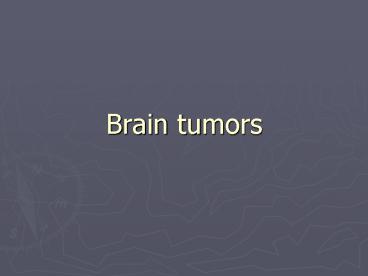Brain tumors - PowerPoint PPT Presentation
1 / 33
Title:
Brain tumors
Description:
... lasics Seizure medicines Narcotic analgetics teratoma. Glioblastoma multiforme large orbital optic glioma in 5-year-old child with neurofibromatosis type 1. – PowerPoint PPT presentation
Number of Views:148
Avg rating:3.0/5.0
Title: Brain tumors
1
Brain tumors
2
Incidence of tumors
- 10-25 per 100.000 population per year
- 5-15 among all tumors
3
Classification of brain tumors
- Tumors of neuroepithelial tissue
- Astrocytic tumors
- Oligodendroglial tumors
- Ependymal tumors
- Mixed gliomas
- Choroid plexus tumors
- Neuronal and mixed neuronal-glial tumors
- Pineal parenchymal tumors
- Embrional tumors
4
Classification of brain tumors
- Tumors of cranial and spinal nerves
- Tumors of the meninges
- Tumors of meningothelial cells
- Mesenchymal nonmeningothelial tumors
- Primary melanocytic lesions
- Tumors of sellar region
- Germ cell tumors
- Lymphomas and hemopoietic neoplasms
- Cysts and tumor-like lesions
- Local extentions from regional tumors
- Metastatic tumors
- Unclassified tumors
5
Surgical classification of brain tumors
- Intracerebral
- Intraventricular
- Extracerebral
- Supratentorial
- Infratentorial
- Exact localization (lobes, basal ganglia, brain
stem, ventricles)
6
Clinical presentations
- Symptoms due to increased intracranial pressure
- Headache
- Vomiting
- Seizures
- Alteration of cognitive functions
- Symptoms due to local dysfunction
- Neurological deficit
- Seizures
- Meningeal signs
- Endocrine symptoms
- Dislocation (herniation) syndromes
7
Diagnostic procedures
- X-ray examination
- CT with and without contrast
- MRI
- Angiography
8
Treatment
- Surgical
- Total and subtotal removal
- Partial removal
- Palliative surgery (Decompresive trepanation,
shunting) - Radiation
- Distant hamma-therapy
- Radiosurgery (Hamma-knife, linear accelerator)
- Chemotherapy
- Hormonoterapy for meningiomas
- Nitrosoureas, vincristine, cyclophosphamide, oth
- Symptomatic conservative treatment
- Anti-edema dexametazone, lasics
- Seizure medicines
- Narcotic analgetics
9
- teratoma.
10
- Glioblastoma multiforme
11
- large orbital optic glioma in 5-year-old child
with neurofibromatosis type 1.
12
- Germinoma of the pineal region obstructing the
third ventricle and causing hydrocephalus.
13
- choroid plexus papilloma.
- After contrast medium administration, the tumor
enhanced homogeneously. The vascular pedicle
leading to the tumor is well appreciated
14
- Preoperative image made without (A) and with (B)
gadolinium enhancement shows fourth-ventricular
invasion of an ependymoma in a child. - C. gadolinium-enhanced image shows the tumor
protruding from the foramen of Luschka into the
cerebellopontine angle on the right. - D. image made postoperatively confirms complete
resection
15
- Postcontrast computed tomography showing
relatively homogeneous enhancement in
medulloblastoma.
16
- Computed tomography of a tumor presenting with
acute hemorrhage. - anaplastic mixed oligoastrocytoma.
17
- A. noncontrast-enhanced CT scan of a cystic
craniopharyngioma This large tumor is almost
isodense with the surrounding brain tissue and is
poorly defined. Two calcified areas on the left
side of the cyst wall are seen, suggesting the
diagnosis. - B. Axial scan following contrast enhancement. The
tumor is well defined, and the cyst wall and
calcifications are seen.
18
- Coronal T1-weighted magnetic resonance images
show a parasagittal malignant meningioma (left)
and its recurrence (right) 8 months after gross
total resection and external beam radiation
therapy.
19
- Vestibular schwannoma
20
- The lower clival meningioma.
- This 53-year-old woman presented with progressive
quadriparesis and left-sided glossopharyngeal,
vagal, accessory, and hypoglossal nerve palsies.
21
- Gyri involved by this infiltrating astrocytoma
are pale, wide, and flat. en bloc resection of a
tumor - Internal decompression of an infiltrative tumor.
22
- Surface presentation of an intraparenchymal
tumor.
23
Hamma-knife
24
Spinal cord tumors
25
Surgical classification
- Intramedullary
- Extramedullary
- Level (cervical, thoracic, lumbar)
26
Histological classification
- Glial
- Astrocytomas
- Ependimomas
- Nerve sheath tumors
- Neurinoma
- neurofibroma
- meningiomas
27
Clinical presentations
- Segmental neurological deficit
- Conduction neurological deficit
- Ascending
- Descending
- Pain
28
Additional methods of diagnosis
- MRI
- Postmyelography CT
- Angiography
29
- Extramedullary tumor on the C1-C2 level
(meningioma)
30
- neurinoma
31
- Intrmedulary tumor
32
(No Transcript)
33
Treatment
- Surgical
- Radiation
- For malignant gliomas































